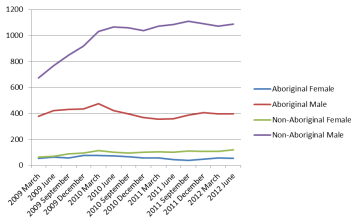A multi-agency review lead by this office in 2008 on the assessment and classification process for assessing security ratings, predicted that changes to the classification tool would slightly decrease the proportion of minimum security prisoners who were Aboriginal. This prediction was based on an analysis of over 16,000 individuals assessed for security classification from 2001 to 2006.
The actual changes brought about by the Department’s new system have been much more marked. The model met its projected outcomes in terms of the flow through of non-Aboriginal prisoners to minimum security. However, Aboriginal prisoners, and especially Aboriginal women, have not achieved minimum security classifications to anything like the projected extent. Indeed, despite a significant rise in the number of Aboriginal people in the prison system as a whole, there has been virtually no increase in the number at minimum security. By contrast, the number of non-Aboriginal people at minimum security has increased sharply.
Specifically:
- The number of non-Aboriginal people acquiring minimum security status has increased by 62 per cent (from 740 to over 1200).
- The number of Aboriginal people attaining minimum security status has increased by less than five per cent (from 432 to 452).
- Non-Aboriginal prisoners comprise 61 per cent of the total prisoner population and 96 per cent of the increase in minimum security prisoners.
- Aboriginal prisoners comprise 39 per cent of the total prisoner population but only 4 per cent of the increase in minimum security.
- In 2009, 37 per cent of the state’s minimum security prisoners were Aboriginal. By 2012 the figure had dropped to 27 per cent.
Figure: Trends in Minimum Security Demographics March 2009 – June 2012
